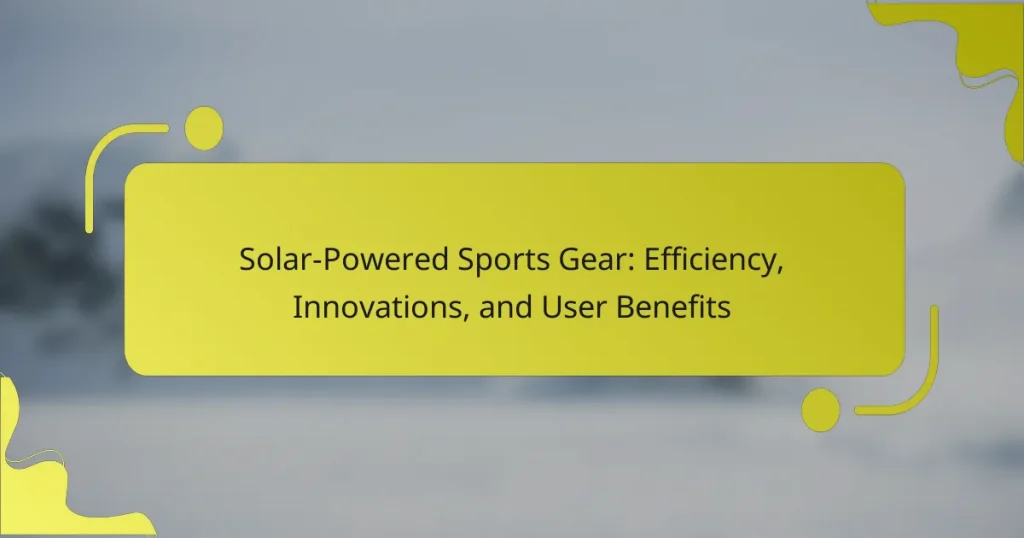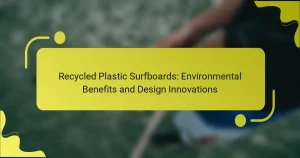Solar-powered sports gear offers enhanced convenience and sustainability for athletes. This article explores the efficiency and innovations of these products, highlighting user benefits and addressing potential challenges. Key features include lightweight designs, integrated solar panels, and extended battery life. The advancements in technology further improve performance while minimizing environmental impact.

What are the key features of solar-powered sports gear?
Solar-powered sports gear features advanced energy efficiency, innovative designs, and significant user benefits. These products harness solar energy to power devices, enhancing performance and convenience. Key features include lightweight materials, integrated solar panels, and durability for outdoor use. Additionally, they often offer extended battery life and eco-friendliness, appealing to environmentally conscious consumers. These attributes make solar-powered sports gear a practical choice for athletes seeking reliable and sustainable solutions.
How does solar technology enhance performance in sports gear?
Solar technology significantly enhances performance in sports gear by integrating energy efficiency, innovative designs, and user benefits. Solar-powered gear, such as smart clothing and accessories, utilizes solar panels to charge devices, reducing reliance on conventional power sources. This technology allows athletes to track performance metrics in real-time, improving training efficiency.
Innovations in materials have led to lightweight, flexible solar panels that seamlessly blend into gear without hindering movement. For example, solar-powered backpacks can charge phones while athletes are on the go. User benefits include extended usage time for devices and the convenience of charging in outdoor environments.
Overall, solar technology transforms sports gear into multifunctional tools, promoting sustainability and enhancing athletic performance.
What materials are commonly used in solar-powered sports gear?
Common materials used in solar-powered sports gear include photovoltaic cells, lightweight polymers, and durable fabrics. Photovoltaic cells convert sunlight into energy, while lightweight polymers enhance flexibility and comfort. Durable fabrics ensure longevity and weather resistance, making them ideal for outdoor sports.
Which brands are leading in solar-powered sports gear innovations?
Leading brands in solar-powered sports gear innovations include Adidas, Nike, and Under Armour. These companies focus on integrating solar technology into apparel and equipment to enhance performance and sustainability. Adidas has developed solar-powered running shoes that utilize photovoltaic cells to charge devices. Nike’s solar innovations include backpacks with built-in solar panels for energy on the go. Under Armour offers solar-powered fitness trackers that optimize training efficiency. These brands are at the forefront, combining technology and eco-friendliness to meet consumer demands.

What benefits do users experience with solar-powered sports gear?
Users experience enhanced convenience, sustainability, and autonomy with solar-powered sports gear. These innovations harness solar energy, reducing reliance on traditional power sources. Users benefit from extended usage times and eco-friendly practices. Additionally, many products feature lightweight designs and integrated charging systems, promoting active lifestyles while minimizing environmental impact.
How does solar-powered gear impact user convenience and efficiency?
Solar-powered sports gear significantly enhances user convenience and efficiency by providing sustainable energy solutions. Users can enjoy extended use without the need for traditional power sources. This innovation allows for seamless integration into outdoor activities, ensuring devices remain operational during extended periods. Additionally, the lightweight nature of solar-powered gear contributes to ease of transport and usability. Enhanced battery life, often exceeding 20 hours, further boosts efficiency, making solar-powered gear a practical choice for athletes and outdoor enthusiasts.
What are the environmental benefits of using solar-powered sports gear?
Using solar-powered sports gear significantly reduces environmental impact by minimizing carbon emissions and reliance on non-renewable energy sources. These innovations harness solar energy, promoting sustainability in sports. Solar gear often includes features like energy-efficient materials and recyclable components, further enhancing their eco-friendliness. Additionally, users contribute to a cleaner environment by choosing gear that supports renewable energy initiatives.
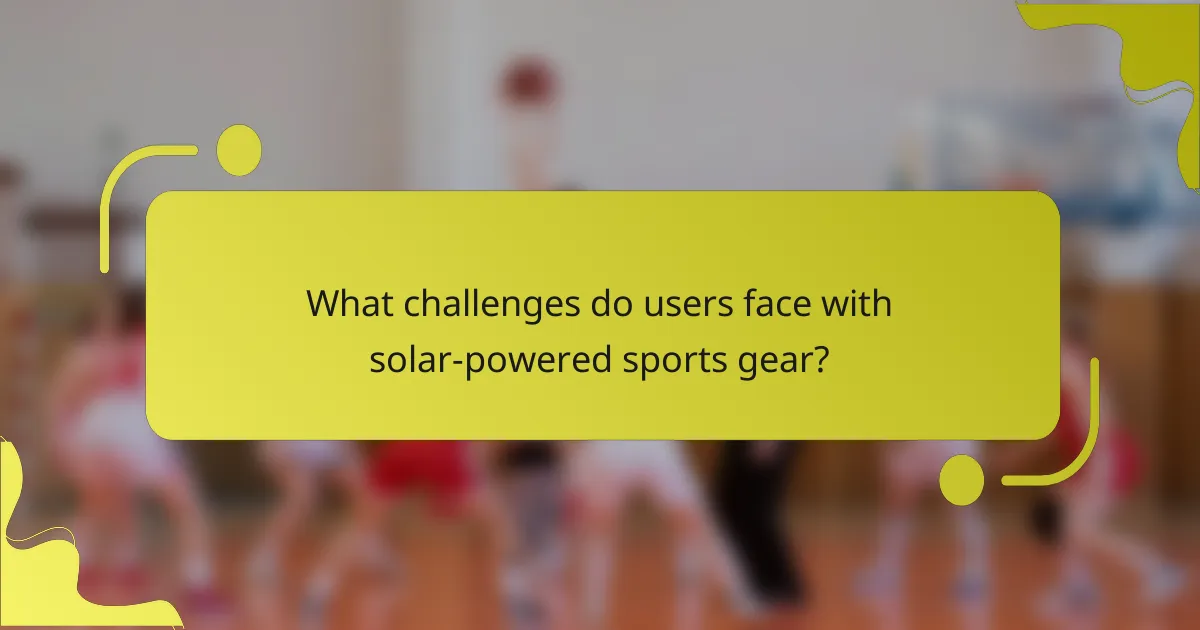
What challenges do users face with solar-powered sports gear?
Users face challenges with solar-powered sports gear primarily due to efficiency limitations and environmental factors. These devices often struggle to maintain optimal performance in low-light conditions. Additionally, the weight and bulkiness of solar panels can affect comfort and usability. Battery life can be inconsistent, leading to reliability issues during extended use. Lastly, high costs can deter users from investing in these innovative products.
How does weather affect the performance of solar-powered sports gear?
Weather significantly impacts the performance of solar-powered sports gear. Factors such as sunlight intensity, temperature, and humidity directly influence energy generation and efficiency.
In bright sunlight, solar panels on gear can achieve optimal performance, maximizing energy capture. Conversely, overcast conditions reduce energy output, potentially affecting the gear’s functionality. High temperatures can also lead to overheating, which may impair the efficiency of solar components.
Additionally, humidity can affect the solar panels’ surface, potentially leading to condensation that reduces their effectiveness. Understanding these weather-related factors helps users optimize their solar-powered sports gear for better performance during outdoor activities.
What maintenance is required for solar-powered sports gear?
Solar-powered sports gear requires minimal maintenance, primarily focusing on cleaning and battery care. Regularly wipe the solar panels to ensure optimal efficiency. Check battery health periodically to prevent degradation. Store gear in a cool, dry place to extend lifespan.
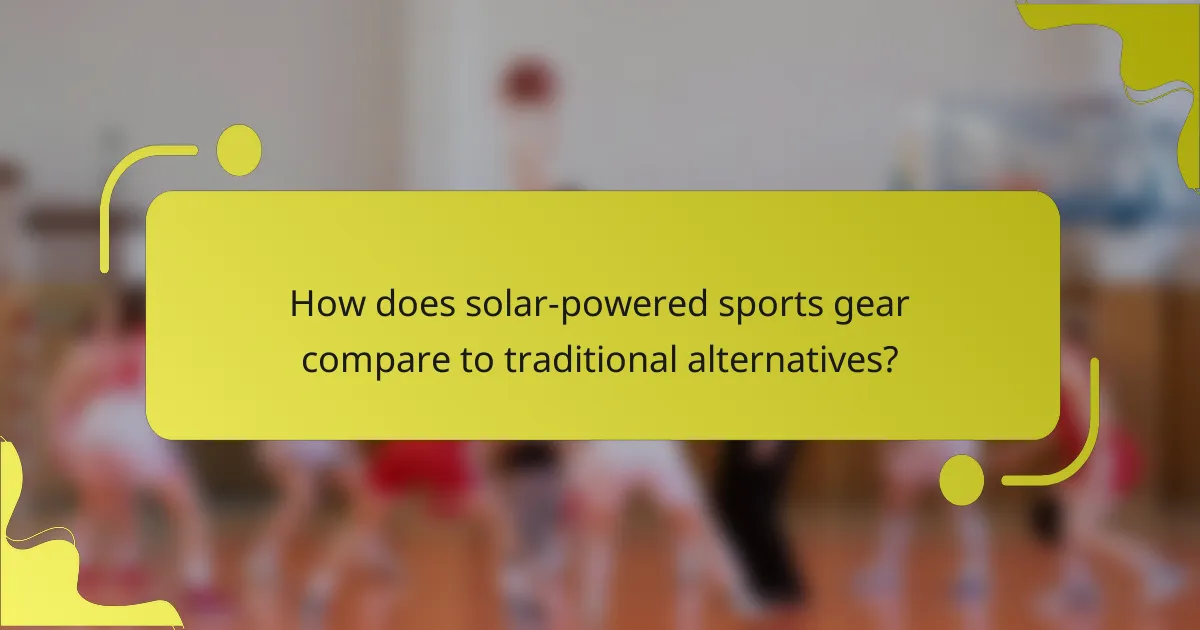
How does solar-powered sports gear compare to traditional alternatives?
Solar-powered sports gear offers greater efficiency and sustainability compared to traditional alternatives. These innovative products harness solar energy, reducing reliance on batteries. Users benefit from longer usage times and lower environmental impact. Traditional gear lacks these energy-efficient features, making solar options increasingly appealing.
| Feature | Solar-Powered Sports Gear | Traditional Sports Gear |
|———————–|————————–|————————-|
| Energy Source | Solar energy | Batteries |
| Environmental Impact | Low | High |
| Usage Duration | Extended | Limited |
| Innovation Level | High | Moderate |
| Maintenance | Minimal | Regular |
What are the cost implications of investing in solar-powered sports gear?
Investing in solar-powered sports gear can lead to long-term savings despite initial costs. These products often have higher upfront prices due to advanced technology and materials. However, they reduce energy expenses and maintenance costs over time.
For example, solar-powered devices can lower electricity bills by harnessing renewable energy. Additionally, many brands offer warranties that extend the lifespan of the gear, enhancing overall value.
Moreover, the growing market for sustainable sports equipment may lead to increased resale values. As consumers prioritize eco-friendly options, investing in solar-powered gear can yield both financial and environmental benefits.
Which types of sports benefit most from solar-powered gear?
Solar-powered gear benefits endurance sports, outdoor activities, and team sports the most. These sports leverage solar technology for extended performance and sustainability.
Endurance sports like running and cycling gain from solar-powered wearables that charge devices during long sessions. Outdoor activities such as hiking and camping benefit from solar-powered equipment that enhances safety and convenience. Team sports utilize solar gear for energy-efficient training tools and game-day technology.
This innovation in sports gear exemplifies a shift towards sustainable practices in athletic performance.
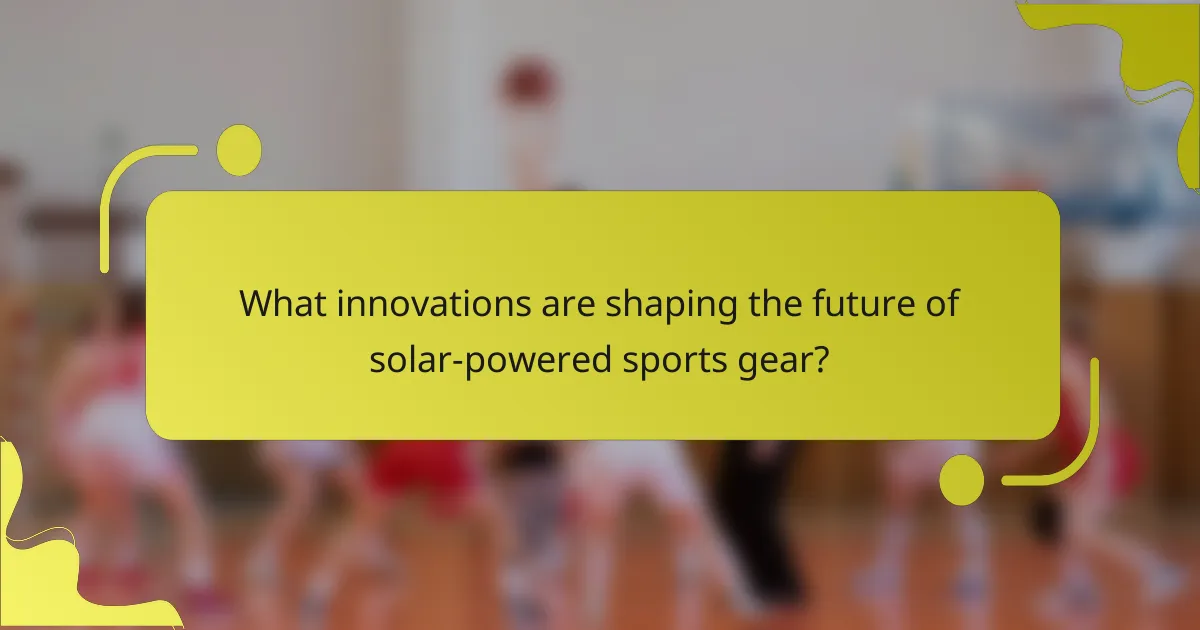
What innovations are shaping the future of solar-powered sports gear?
Innovations in solar-powered sports gear are enhancing efficiency and user experience. Key advancements include lightweight solar panels integrated into apparel, improving energy capture and usability. Smart technology integration allows for real-time performance tracking and energy management. Enhanced durability and weather resistance are also significant, ensuring gear can withstand various conditions. These innovations lead to increased energy efficiency, enabling athletes to power devices sustainably during activities.
How are advancements in solar panel technology influencing sports gear?
Advancements in solar panel technology significantly enhance solar-powered sports gear by improving efficiency and user benefits. Innovations in lightweight, flexible solar cells enable gear to harness energy without compromising performance.
These solar panels can charge devices like fitness trackers and smartwatches during outdoor activities, providing convenience and extended usage. For instance, some solar-powered backpacks can generate enough energy to power small electronics, promoting sustainability in sports.
The integration of these technologies also encourages athletes to engage in eco-friendly practices. As a result, athletes can enjoy the benefits of renewable energy while minimizing their carbon footprint.
What role do user feedback and testing play in developing new solar-powered sports gear?
User feedback and testing are crucial for optimizing solar-powered sports gear. They ensure products meet user expectations and enhance performance. By gathering insights on usability and efficiency, manufacturers can identify areas for innovation. This iterative process leads to improved designs, maximizing user benefits, such as extended battery life and increased comfort. Testing also reveals unique attributes that differentiate products in a competitive market, driving further advancements in solar technology within sports gear.
Which emerging trends should users watch for in solar-powered sports gear?
Users should watch for advancements in energy efficiency, lightweight materials, and multifunctional designs in solar-powered sports gear. Emerging trends include enhanced solar panel technology that increases energy capture and storage capabilities, allowing for longer usage during activities. Innovations in materials, such as flexible and durable fabrics, improve comfort and performance while integrating solar technology. Additionally, smart features, like connectivity to fitness apps, are becoming common, providing users with real-time data on energy consumption and performance metrics. These trends highlight the growing focus on sustainability and enhanced user experience in the sports gear market.
What are the best practices for maximizing the efficiency of solar-powered sports gear?
To maximize the efficiency of solar-powered sports gear, focus on optimal solar panel placement, lightweight materials, and energy storage solutions. Proper alignment with sunlight enhances energy capture. Using advanced materials reduces weight, improving performance. Efficient batteries ensure prolonged usage during activities.
